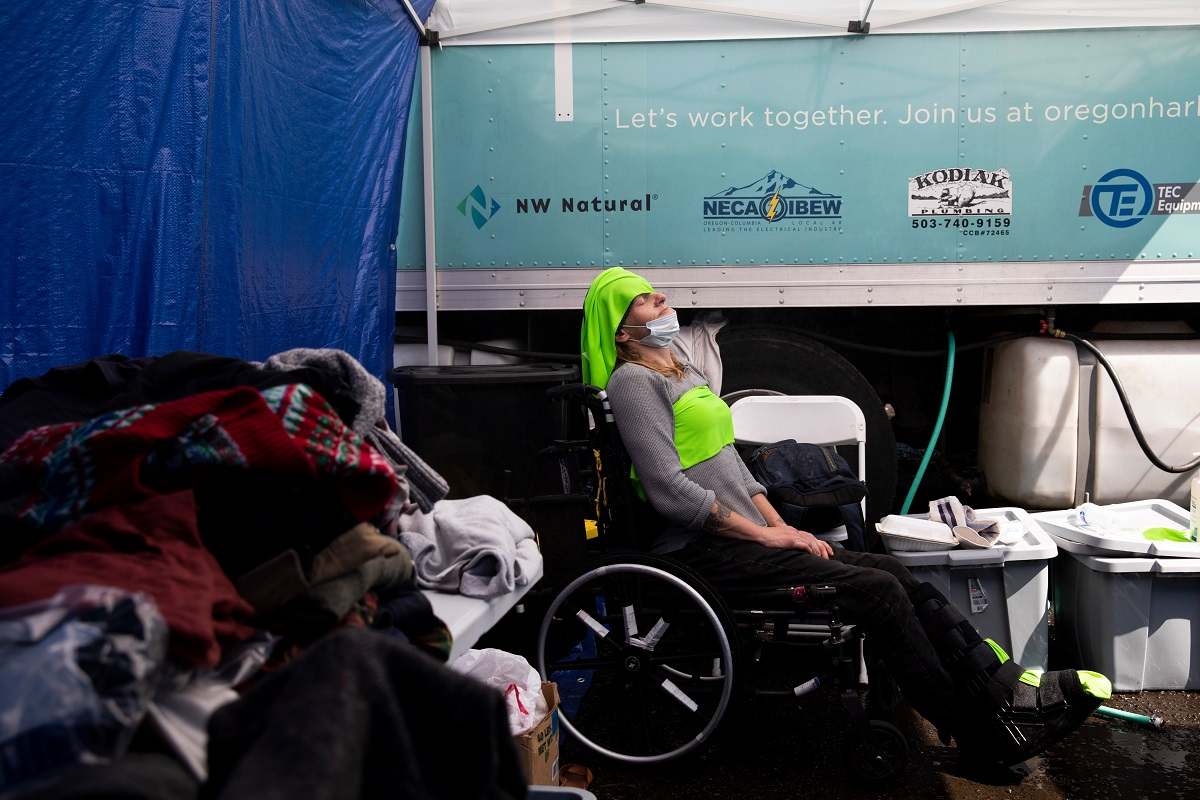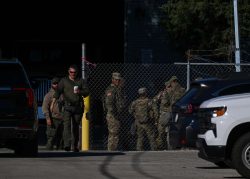
Tracy Wallace, 42, puts ice cold cloths on her forehead and chest to stay cool at the Sunrise Center cooling center in Portland, Ore., on June 27, 2021.
15:57 JST, July 16, 2023
As U.S. cities again confront dangerous heat waves – including triple-digit temperatures across southern and western states – many cities are recommending that vulnerable groups seek refuge at cooling centers. These are air-conditioned buildings that are designated as a safe place during extreme heat events.
While cooling centers are a potentially helpful measure for some people, experts say they may not be an effective or realistic solution for everyone, and can too easily be seen as a panacea.
There are various challenges. Elderly people are often uncomfortable relocating to an unfamiliar setting, even one with good air conditioning. Public awareness is another, since the most vulnerable may be the least wired. And access to them – especially in cities with marginal public transportation – adds to the hurdles.
“Cooling centers are fine as long as you can get there,” said Larry Kalkstein, the chief heat science adviser at Arsht-Rockefeller Foundation Resilience Center. He called cooling centers a “temporary fix,” and added that lack of accessibility is a major drawback.
On Friday, nearly 115 million Americans were under heat alerts from South Florida to the interior of Washington state. Many states have worked to open up cooling centers, and for good reason.
Heat is the leading cause of weather-related fatalities and injuries across the country, according to the National Weather Service. An estimated 148 people died because of heat in 2022. Older adults, especially those who are poor, are most at risk, especially those with physical or cognitive impairments. Additional vulnerable groups include children, the homeless and outside workers, according to the Centers for Disease Control and Prevention (CDC).
Cool environments during heat waves help people avoid the worst threats. They “save lives,” said Kristie Ebi, a professor at the University of Washington’s Center for Health and the Global Environment.
But, according to Ebi, cooling centers won’t be effective unless they are accessible to the most at-risk people. This requires that they know about their location and have means to travel.
In 2017, the CDC published a review on the implementation of cooling centers and concluded their effectiveness is “unclear.”
Elena Grossman, who co-authored the CDC report, said the review found that cooling centers were beneficial for protecting health, but have major limitations because of accessibility concerns, the lack of things to do for visitors and certain stigmas associated with the centers.
“We need to be creative in thinking about how we make them accessible and not perceived as [a space] for certain groups of people,” said Grossman, a senior research specialist in the University of Illinois Chicago’s School of Public Health. Many people stigmatized cooling centers to be for poor or old people, she said.
According to a study published in Applied Geography this year based on the smartphone data of Los Angeles residents, roughly one-fifth of those residents used cooling centers in 2017, and the vast majority of those sought out informal cooling centers, such as shopping malls and movie theaters.
Grossman believes that such informal facilities could offer alternatives to combat the stigmas associated with cooling centers. “We need to think more creatively about what a cooling center is and then try to address some of the stigma associated with it,” she said.
Even those motivated to visit a cooling center may face impediments. Older adults, some of whom have mobility limitations, and small children, may have a harder time walking or finding transportation.
According to a 2021 study published in International Journal of Environmental Research and Public Health that examined 25 cities, only 10.3 percent of people were within walking distance – about half a mile – of a cooling center, on average. In California cities such as Fresno and San Jose, and Arizona cities Phoenix and Mesa, less than 5 percent of the population was within walking distance, the study said.
“If these centers aren’t located near where people live or along a public transit line, it can be very difficult,” said Joan Casey, an assistant professor at University of Washington’s Center for Health and the Global Environment.
Moreover, the cost of transportation may make it impossible for low income individuals to access them.
A cooling center evaluation report in Arizona’s Maricopa County found that 84 percent of cooling center visitors surveyed were unemployed. More than a fourth of total visitors said that electricity costs or unit malfunctions prevent them from using air conditioner. Nearly 55 percent accessed cooling centers by walking or using public transportation.
While cooling centers may pose accessibility challenges for those in urban areas, reaching them is an impossibility for those who live far away.
Data analyzing emergency room visits involving heat stress, published in the Journal of Community Health, found that there was a significantly higher rate of visits in rural compared to urban counties. People in rural areas may also be less willing or able to drive long distances for cooling assistance, the report said.
Even for those who find a way to cooler centers, limited hours – which generally span the time of an average workday – leave many without a way to avoid the heat in the evening.
During extended and particularly intense heat waves, nighttime temperatures can also be dangerous. The most severe health effects tend to happen when the heat doesn’t dissipate much at night, Casey said.
When that heat lingers, Casey said, the body doesn’t have a chance to recover from the stress of sweltering daytime temperatures.
This week, nighttime lows in parts of the southern half of the country are predicted to only dip into the 90s.
“Cooling centers often don’t deal with that problem because generally people are not sleeping in cooling centers,” Casey said.
Grossman said because of these constraints, cooling centers can’t be the only solution. Combating heat involves a multilayered approach, including parks and tree canopies, white roofs, which reflects the sun’s rays, and energy efficiency practices, to relieve pressure on the power grid, she said.
“There is a place for cooling centers in heat response plan,” Grossman said. But she added: “None of these strategies can be done alone. You can’t just rely on a cooling center to solve all of our problems.”
"News Services" POPULAR ARTICLE
-

American Playwright Jeremy O. Harris Arrested in Japan on Alleged Drug Smuggling
-

Japan’s Nikkei Stock Average as JGB Yields, Yen Rise on Rate-Hike Bets
-

Japan’s Nikkei Stock Average Licks Wounds after Selloff Sparked by BOJ Hike Bets (UPDATE 1)
-

Japan’s Nikkei Stock Average Buoyed by Stable Yen; SoftBank’s Slide Caps Gains (UPDATE 1)
-

Japanese Bond Yields Zoom, Stocks Slide as Rate Hike Looms
JN ACCESS RANKING
-

Tokyo Economic Security Forum to Hold Inaugural Meeting Amid Tense Global Environment
-

Keidanren Chairman Yoshinobu Tsutsui Visits Kashiwazaki-Kariwa Nuclear Power Plant; Inspects New Emergency Safety System
-

Imports of Rare Earths from China Facing Delays, May Be Caused by Deterioration of Japan-China Relations
-

University of Tokyo Professor Discusses Japanese Economic Security in Interview Ahead of Forum
-

Japan Pulls out of Vietnam Nuclear Project, Complicating Hanoi’s Power Plans
























